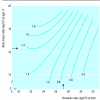Catch-up growth in childhood and death from coronary heart disease: longitudinal study
- PMID: 9974455
- PMCID: PMC27731
- DOI: 10.1136/bmj.318.7181.427
Catch-up growth in childhood and death from coronary heart disease: longitudinal study
Abstract
Objective: To examine whether catch-up growth during childhood modifies the increased risk of death from coronary heart disease that is associated with reduced intrauterine growth.
Design: Follow up study of men whose body size at birth was recorded and who had an average of 10 measurements taken of their height and weight through childhood.
Setting: Helsinki, Finland.
Subjects: 3641 men who were born in Helsinki University Central Hospital during 1924-33 and who went to school in Helsinki.
Main outcome measures: Hazard ratios for death from coronary heart disease.
Results: Death from coronary heart disease was associated with low birth weight and, more strongly, with a low ponderal index at birth. Men who died from coronary heart disease had an above average body mass index at all ages from 7 to 15 years. In a simultaneous regression the hazard ratio for death from the disease increased by 14% (95% confidence interval 8% to 19%; P<0.0001) for each unit (kg/m3) decrease in ponderal index at birth and by 22% (10% to 36%; P=0.0001) for each unit (kg/m2) increase in body mass index at 11 years of age. Body mass index in childhood was strongly related to maternal body mass index, which in turn was related to coronary heart disease. The extent of crowding in the home during childhood, although related to body mass index in childhood, was not related to later coronary heart disease.
Conclusion: The highest death rates from coronary heart disease occurred in boys who were thin at birth but whose weight caught up so that they had an average or above average body mass from the age of 7 years. Death from coronary heart disease may be a consequence of poor prenatal nutrition followed by improved postnatal nutrition.
Figures


References
-
- Barker DJP, Osmond C, Winter PD, Margetts B, Simmonds SJ. Weight in infancy and death from ischaemic heart disease. Lancet. 1989;2:577–580. - PubMed
-
- Martyn CN, Barker DJP, Osmond C. Mothers’ pelvic size, fetal growth, and death from stroke and coronary heart disease in men in the UK. Lancet. 1996;348:1264–1268. - PubMed
Publication types
MeSH terms
LinkOut - more resources
Full Text Sources
Medical
